Prioritisation
At the beginning of the project in 2016, a transparent prioritisation framework was devised and approved by the Trust’s Biodiversity and Green Corridors Subcommittee. The prioritisation analysis forms the basis of all Trust investments in environmental weed biocontrol across Stages 1 to 4.
The prioritisation analysis is based on a matrix assessment system that involved:
- Initial screening steps to identify eligible weeds. Only widespread or emerging environmental weeds in NSW are eligible for analysis if there was existing biocontrol research (either in Australia or overseas) focused on developing and releasing new classical biocontrol agents (arthropods or pathogens). Weeds were included if they had promising candidate agents identified, required host-specificity testing, nomination as a biocontrol target, or preparation of a release application, or if they had approved agents needing further release, monitoring, or evaluation in NSW. Excluded from the analysis were native Australian species, weeds classified as prohibited matter, under control order, or not present in NSW, as well as weeds for which no relevant biocontrol research had ever been performed, those where all suitable agents had already been released and no new promising agents were available, and weeds with major unresolved conflicts of interest (such as valued crops or ornamentals). Exploratory surveys for novel agents in the native range were also excluded unless under exceptional circumstances.
- An assessment of the threat each weed poses to natural ecosystems. Threats for eligible weeds were assessed using the NSW Weed Risk Assessment (WRA) system, which evaluates each weed’s invasiveness, environmental and economic impacts, and potential distribution. The resulting WRA score determines the weed’s threat category (low, moderate, high, or very high), ensuring that prioritisation focuses on weeds posing the greatest risk to biodiversity and natural environments in NSW.
- The feasibility of undertaking a biocontrol project for each weed using the most promising candidate biocontrol agent. The feasibility dimension of the assessment considered whether there were any insurmountable obstacles to undertaking a biocontrol project for each weed and its candidate agent. This included evaluating factors such as the existence of promising candidate agents, logistical challenges (like access to agents or test plants), research infrastructure and collaborative links, potential conflicts of interest, and whether all realistic options for biocontrol had already been explored.
- The likelihood of the selected agent being successful at controlling the weed if released in a new environment. This was defined as the probability that a biocontrol project would achieve its intended goal, namely, effective and sustained control of the target weed in NSW. This was based on available knowledge about the agent’s biology, specificity, ability to damage the weed, synchrony with the weed’s life cycle, environmental adaptability, and potential for establishment and impact under Australian conditions. Weeds were categorised as having low, moderate, or high likelihood of success.
The prioritisation framework was used to produce a justified list of biocontrol weed targets, prioritised according to their highest prospects for biocontrol (based on a combination of feasibility and likelihood of success) among the highest-risk environmental weed species.
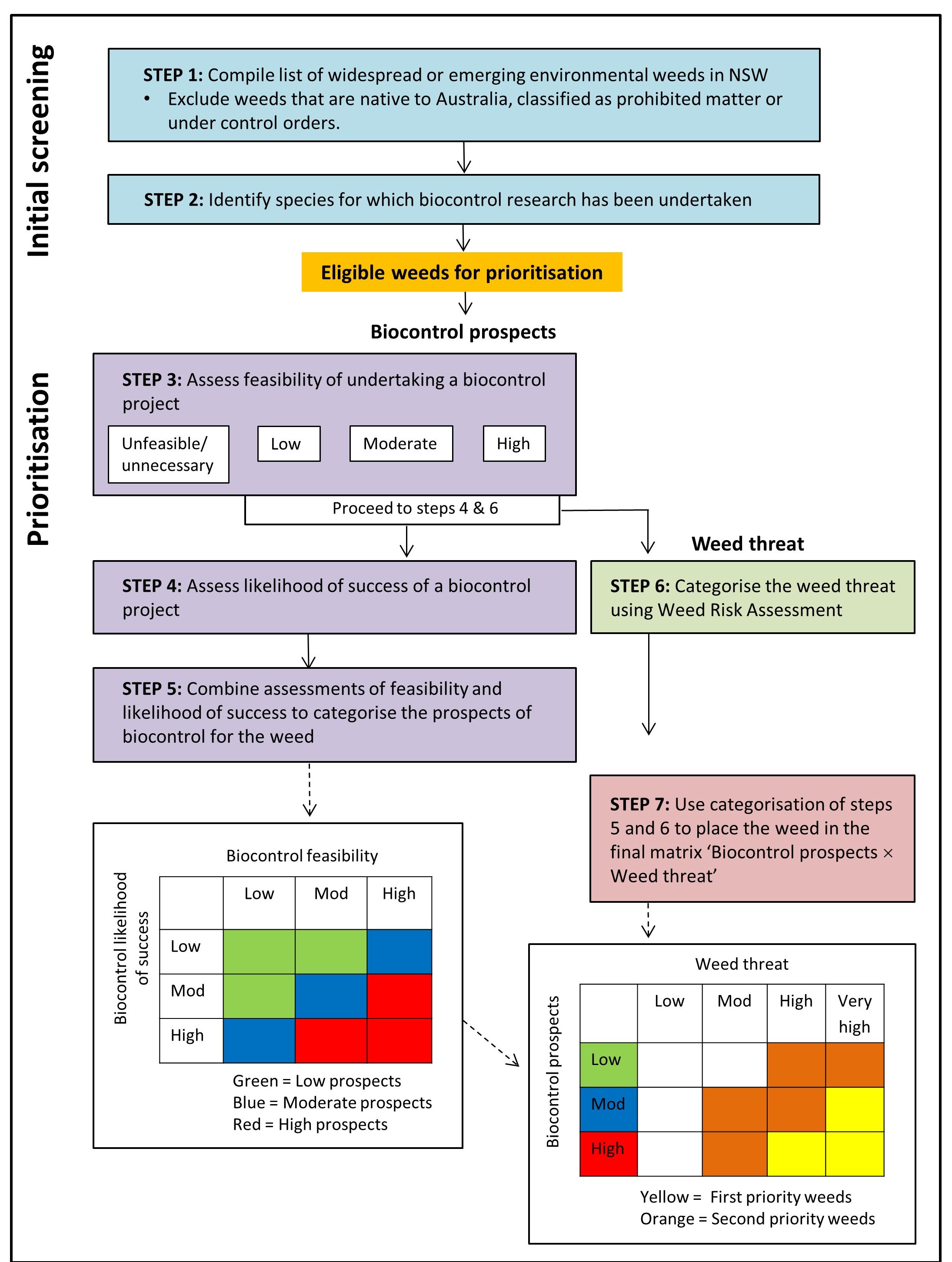
Schematic of prioritisation framework.
Analysis 1 – 2016/17
Led by Louise Morin
[insert link to pdf]
The prioritisation framework was applied to generate a justified, priority list of biocontrol weed targets. Of the 67 eligible weeds identified and assessed, it was deemed unfeasible or unnecessary, for a range of reasons, to undertake a biocontrol project for 49 weeds. The priority list comprised the remaining 18 weeds, each allocated to a cell in a matrix of weed threat versus biocontrol prospects.
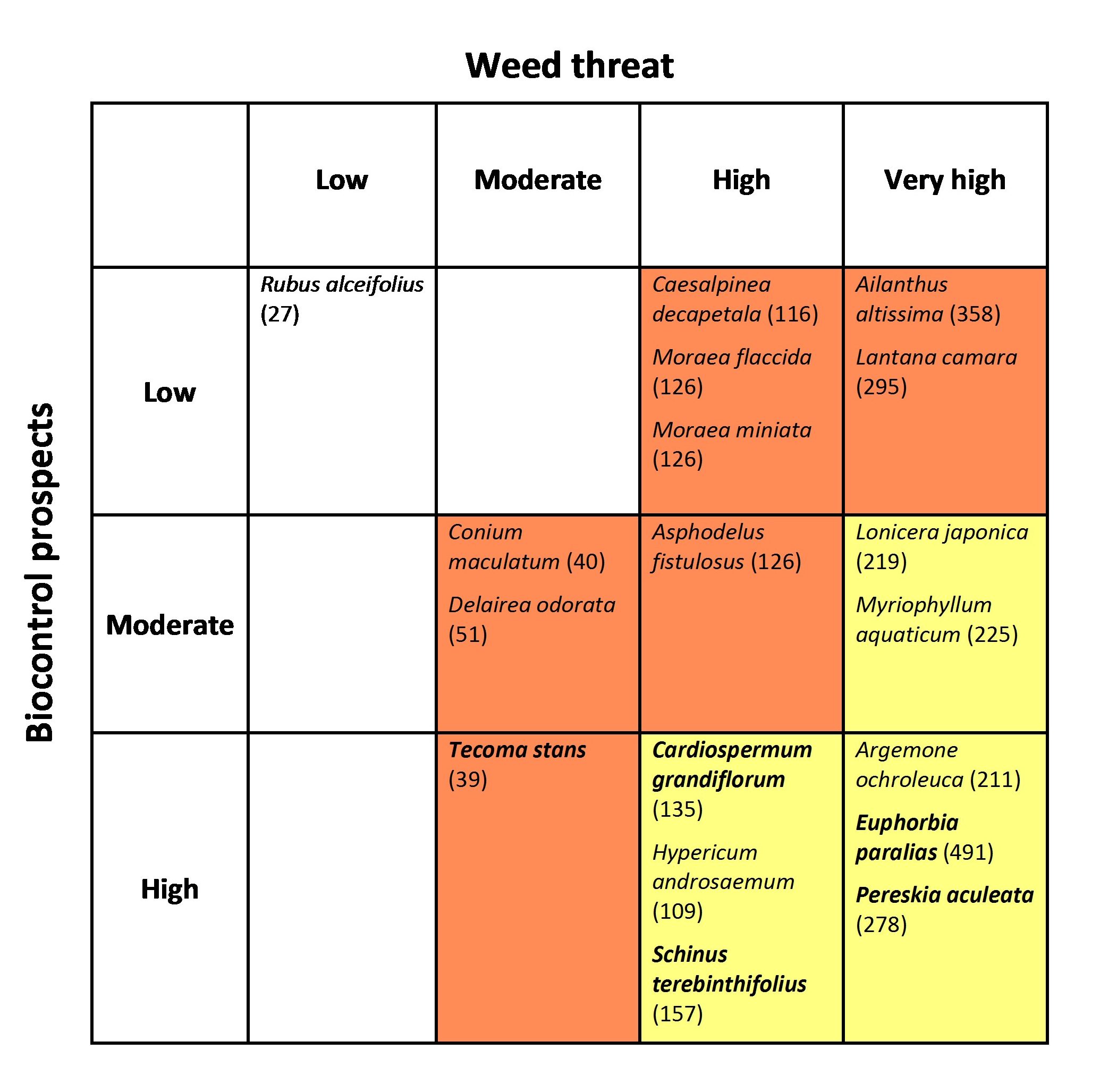
Results from the 2016 prioritisation: Weeds classified according to weed threat and biocontrol prospects with the most promising candidate biocontrol agent. Number in parentheses corresponds to the Weed Risk Assessment score for the weed. Weeds in the yellow cells are considered first priority, and those in the orange cells are second priority.
Considering the first and second priority weeds identified and resources available in 2017, the Trust’s Biodiversity and Green Corridors Subcommittee selected five weeds for initial investment for the period July 2017 to October 2021 Balloon vine (Cardiospermum grandiflorum), broad-leaved pepper tree (Schinus terebinthifolius), leaf cactus (Pereskia aculeata), sea spurge (Euphorbia paralias) and yellow bells (Tecoma stans).
Analysis 2 – 2019/20
Led by Louise Morin
[insert link to pdf]
In 2019 a review and update of the prioritisation of weed targets/promising agents undertaken in 2016 was performed. Options for investment in a second most promising agent for selected weeds, and in recently approved and released agents in Australia that are relevant for NSW were also outlined to assist decision making by the Trust’s Biodiversity and Green Corridors Subcommittee.
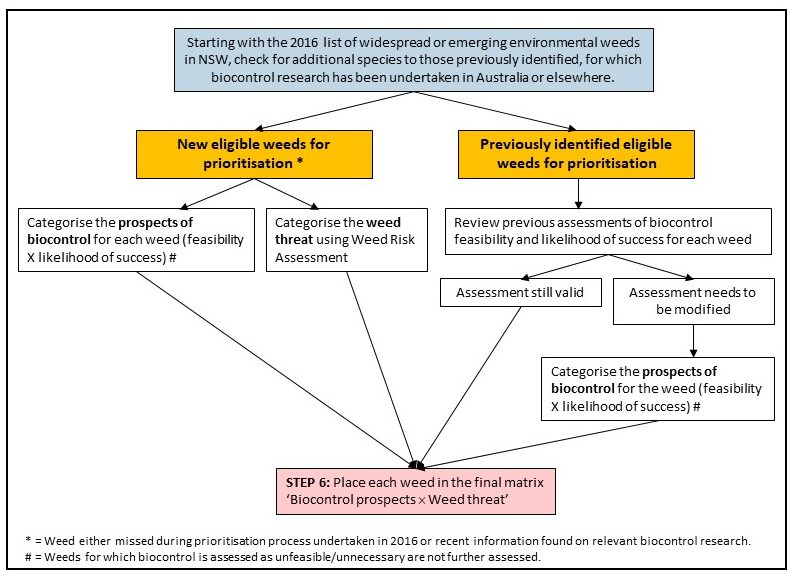
Approach taken for the review and update the prioritisation process first undertaken in 2016.
Of the 72 eligible weeds assessed, biocontrol was deemed unfeasible or unnecessary for 50. The remaining 22 weeds were classified according to biocontrol feasibility and likelihood of success to generate a ranking for biocontrol prospects. Each weed was then allocated to a cell in the matrix ‘Biocontrol prospects x Weed threat’.
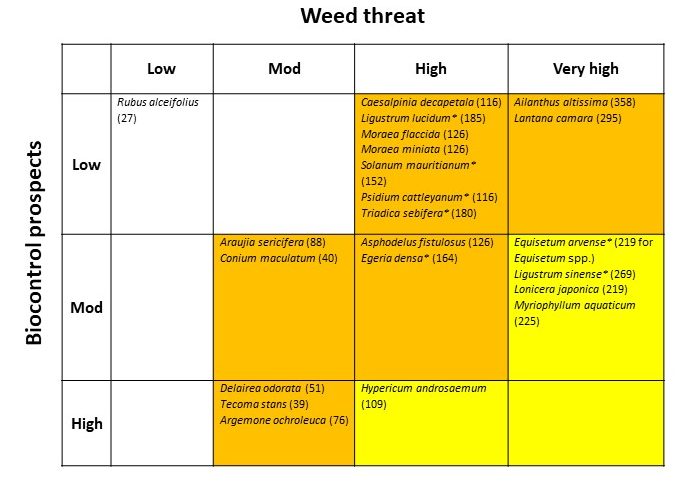
Results from the 2019 prioritisation: Weeds classified according to weed threat and biocontrol prospects with the most promising candidate biocontrol agent. Number in parentheses corresponds to the Weed Risk Assessment score for the weed. Weeds in the yellow cells are considered first priority, and those in the orange cells are second priority. Weeds with Asterix were either missed during the prioritisation process undertaken in Stage I or recent information has been found on relevant biocontrol research.
Following deliberations, the Trust’s Biodiversity and Green Corridors Subcommittee selected the following options for investments for the period from July 2020 to June 2023: (i) large-scale releases and evaluation of the leaf-smut fungus Kordyana brasiliensis for the biocontrol of wandering trad (Tradescantia fluminensis) in NSW, (ii) testing of the privet lace bug Leptoypha hospita, a potential biocontrol agent for small-leaf privet (Ligustrum sinense), on the sole native Ligustrum species in Australia (~1 year), (iii) host-specificity testing of the root-feeding weevil Cyphocleonus trisulcatus, a potential biocontrol agent for ox-eye daisy (Leucanthemum vulgare).
Analysis 3 – 2021/22
Led by Louise Morin
[insert link to pdf]
In 2021, the prioritisation of weed biocontrol targets for NSW was reviewed and updated, building on the framework and results from 2016 and 2019. The review began with a comprehensive list of 266 key environmental weeds for NSW. After excluding native species, prohibited matter, and weeds under control orders, 256 weeds remained. Of these, only 80 had relevant biocontrol research performed in Australia or elsewhere. Each eligible weed was reassessed for biocontrol feasibility and likelihood of success, with updated information from recent research and direct consultation with researchers where needed.
Of the 80 eligible weeds, biocontrol was assessed as unfeasible or not an option for 59, due to reasons such as lack of promising agents, major logistical challenges, or all suitable agents already being released. The remaining 21 weeds were classified according to biocontrol feasibility and likelihood of success, generating a ranking for biocontrol prospects. Each weed was then allocated to a cell in the matrix ‘Biocontrol prospects x Weed threat’, using updated Weed Risk Assessment scores.
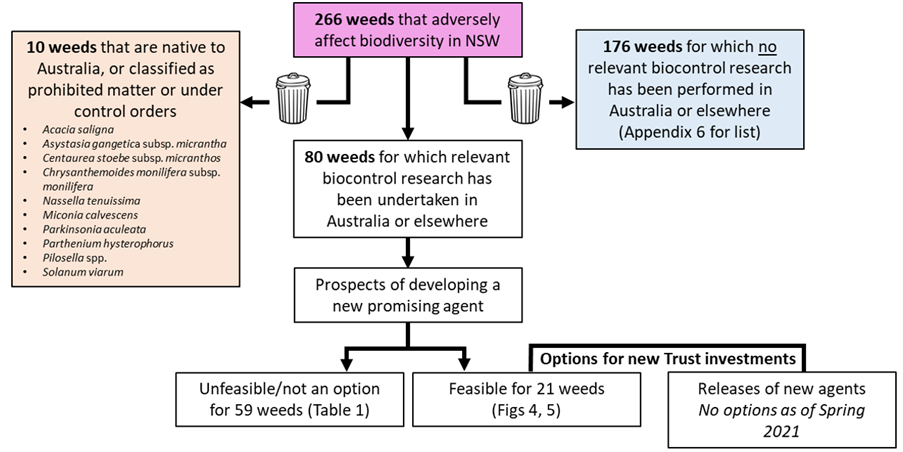
Approach taken for the review and update the prioritisation process first undertaken in November 2021.
Weeds with high biocontrol prospects and high or very high weed threat included Pereskia aculeata (leaf-feeding beetle Phenrica guerini), Schinus terebinthifolius (leaf-galling psyllid Calophya latiforceps), and Tecoma stans (leaf-feeding beetle Mada polluta). Weeds with moderate prospects included Lonicera japonica (stem-boring beetle Oberea shirahatai) and Delairea odorata (leaf-mining moth Digitivalva delaireae).
The review also identified that all new agents recently approved for release in Australia and relevant for NSW were already being supported for field releases by the Trust or other funding sources.
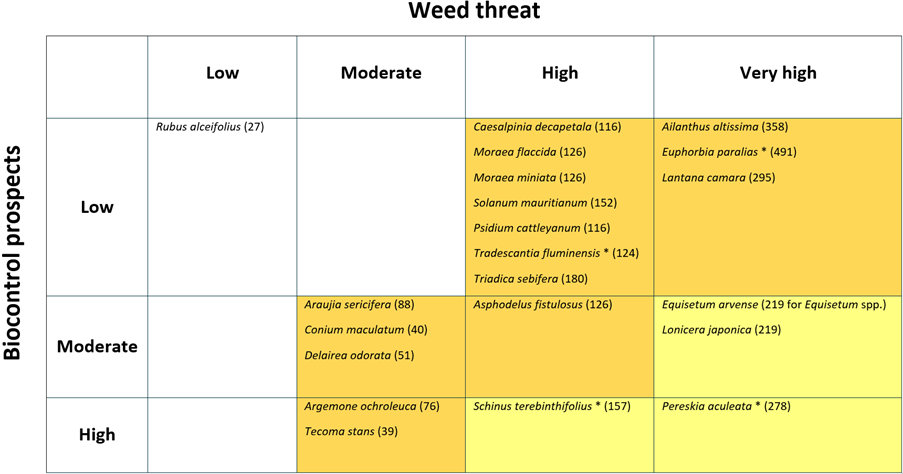
Results from the 2021 prioritisation: Weeds classified according to weed threat and biocontrol prospects with the most promising candidate biocontrol agent. Number in parentheses corresponds to the Weed Risk Assessment score for the weed. Weeds in the yellow cells are considered first priority, and those in the orange cells are second priority.
Analysis 4 – 2022/23
Led by Ben Gooden
[insert link to pdf]
In March 2023, a further review and update of the prioritisation of weed biocontrol targets for NSW was completed, building on the framework and results from 2016, 2019, and 2021. The review began with a comprehensive list of 266 key environmental weeds for NSW. After excluding native species, prohibited matter, and weeds under control orders, 81 weeds were identified as eligible for prioritisation based on the existence of relevant biocontrol research in Australia or overseas. Each eligible weed was reassessed for biocontrol feasibility and likelihood of success, using updated research and direct consultation with national and international experts.
Of the 81 eligible weeds, biocontrol was assessed as unfeasible or not an option for 60, due to factors such as lack of promising agents, major logistical challenges, or all suitable agents already being released. The remaining 21 weeds were classified according to biocontrol feasibility and likelihood of success, generating a ranking for biocontrol prospects. Each weed was then allocated to a cell in the matrix ‘Biocontrol prospects x Weed threat’, using updated Weed Risk Assessment scores.
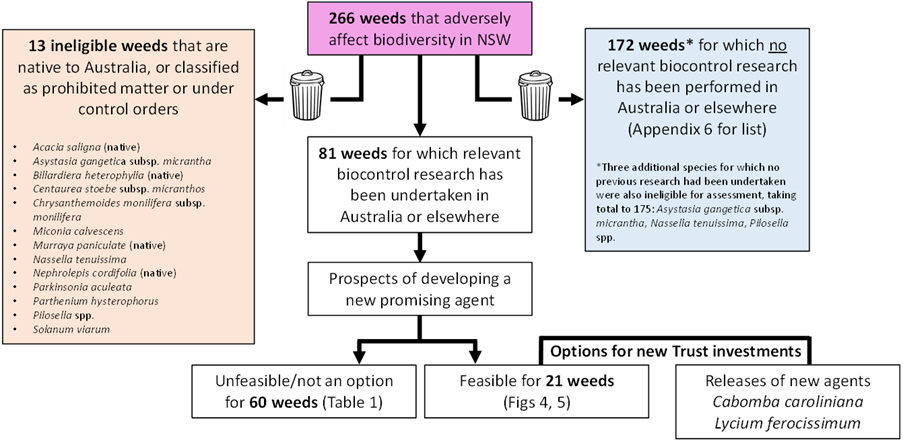
Approach taken for the review and update the prioritisation process first undertaken in March 2023.
Most eligible weeds (13 of 21) were deemed to have low prospects for biocontrol, with only four weeds, Lycium ferocissimum (African boxthorn, rust fungus Puccinia rapipes), Cabomba caroliniana (cabomba weevil Hydrotimetes natans), Tecoma stans (leaf-feeding beetle Mada polluta), and Argemone ochroleuca (flower/fruit/root-feeding beetle Conotrachelus cf. leucophaeatus) classified as having high biocontrol prospects. Of these, Lycium ferocissimum and Cabomba caroliniana were also Weeds of National Significance and ranked as top priorities for future research and investment, particularly as their agents had recently been approved for release but lacked funding for mass-release in NSW. Nassella neesiana (Chilean needle grass, rust fungus Uromyces pencanus) was also identified as a top priority due to its very high threat, despite only moderate biocontrol prospects.
The review also noted that all new agents recently approved for release in Australia and relevant for NSW were already being supported for field releases by the Trust or other funding sources.
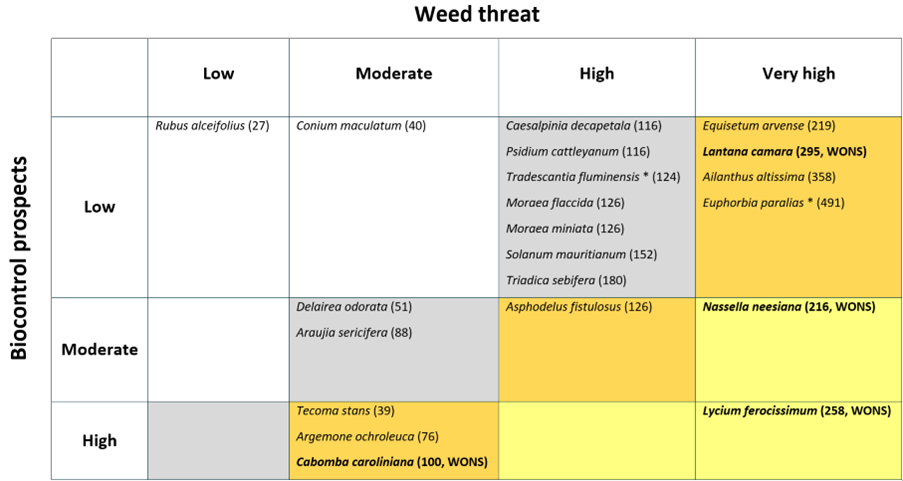
Results from the 2023 prioritisation: Weeds classified according to weed threat and biocontrol prospects with the most promising candidate biocontrol agent. Number in parentheses corresponds to the Weed Risk Assessment score for the weed. Weeds in the yellow cells are considered first priority, and those in the orange cells are second priority.
Analysis 5 – 2025 prioritisation review and update
Led by Ben Gooden
[insert link to pdf]
In March 2025, the fourth review and update of the prioritisation of environmental weed biocontrol targets for NSW was completed to inform investment decisions for Stage 4 of the NSW Environmental Trust’s weed biocontrol program. The review began with the same list of 266 key environmental weeds. After excluding native species, prohibited matter, weeds under control orders, and those not present in NSW, 82 weeds were identified as eligible for prioritisation based on the existence of relevant biocontrol research in Australia or overseas. Each eligible weed was reassessed for biocontrol feasibility and likelihood of success, using updated research, expert consultation, and the established prioritisation framework.
Of the 82 eligible weeds, biocontrol was assessed as unfeasible or not an option for 51, due to factors such as lack of promising agents, major logistical challenges, or all suitable agents already being released. The remaining 31 weeds were classified according to biocontrol feasibility and likelihood of success, generating a ranking for biocontrol prospects. Each weed was then allocated to a cell in the matrix ‘Biocontrol prospects x Weed threat’, using updated Weed Risk Assessment scores.
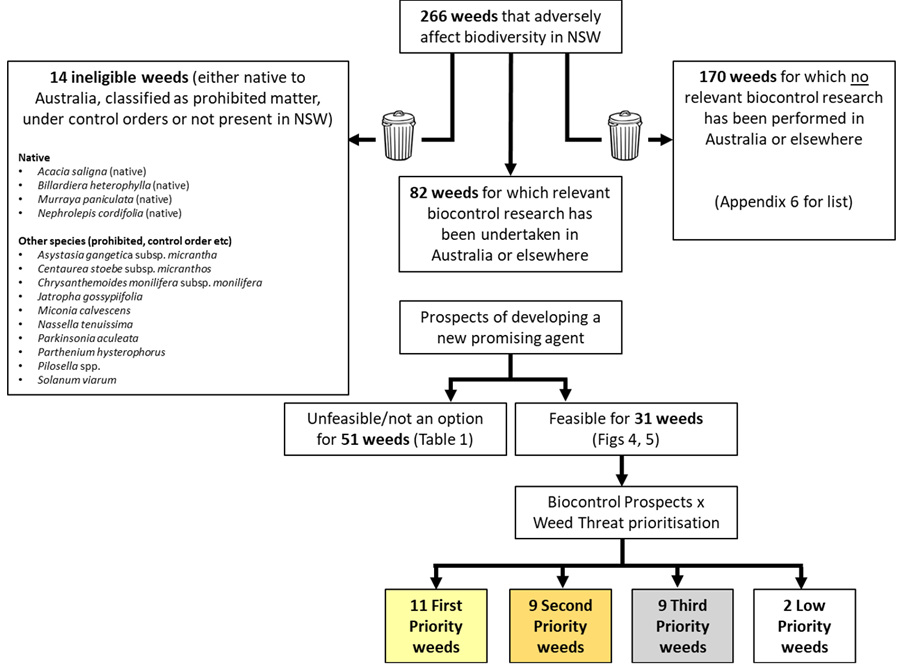
Approach taken for the review and update the prioritisation process first undertaken in 2025
First Priority (highest investment value): Eleven weeds were identified as top priorities, combining high to very high threat and moderate to high biocontrol prospects. These include Arundo donax (giant reed), Egeria densa (leafy elodea), Myriophyllum aquaticum (parrot’s feather), Rubus fruticosus complex (blackberry), Hyparrhenia hirta (Coolatai grass), Ligustrum sinense (small-leaf privet), Kalanchoe delagoensis and K. x houghtonii (mother-of-millions), Leucanthemum vulgare (ox-eye daisy), Tecoma stans, Cylindropuntia pallida (Hudson pear), and Tradescantia fluminensis (wandering trad). For some, such as Hudson pear and wandering trad, further releases of already approved agents were recommended; for others, investment in host-specificity testing, nomination as biocontrol targets, or preparation of release applications was prioritised.
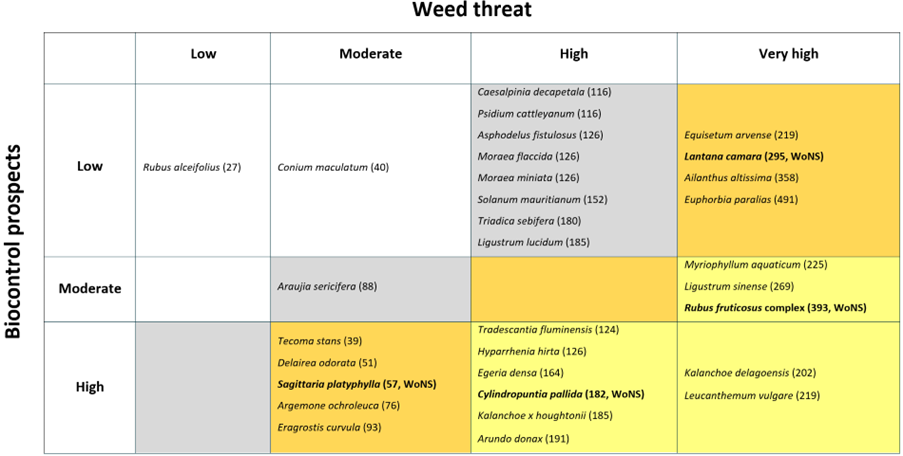
Results from the 2025 prioritisation: Weeds classified according to weed threat and biocontrol prospects with the most promising candidate biocontrol agent. Number in parentheses corresponds to the Weed Risk Assessment score for the weed. Weeds in the yellow cells are considered first priority, and those in the orange cells are second priority.
